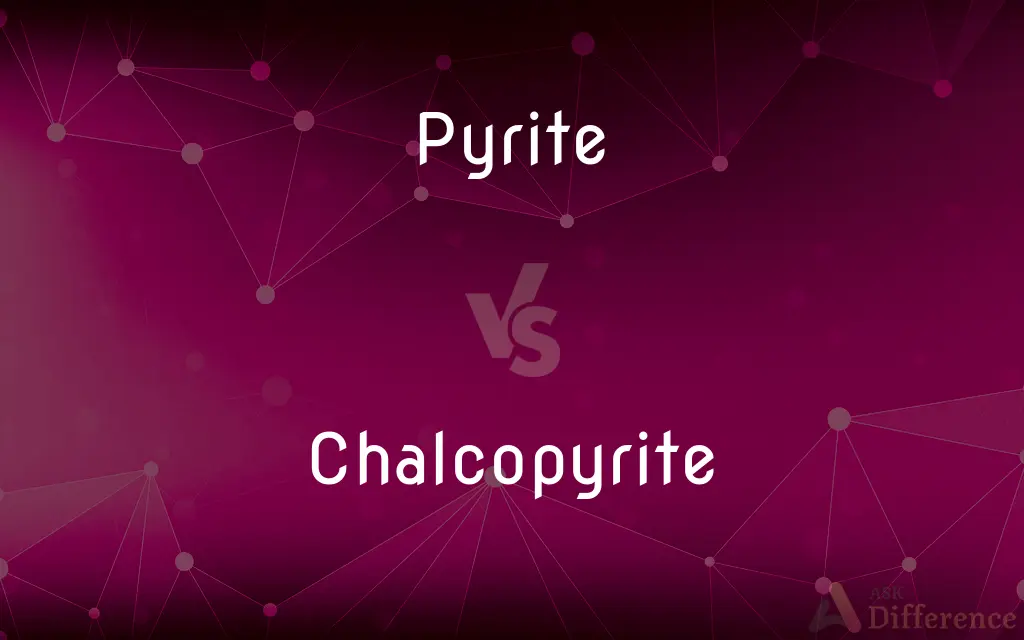Pyrite vs. Chalcopyrite — What's the Difference?
By Tayyaba Rehman — Updated on September 23, 2023
Pyrite is an iron sulfide mineral with a gold-like appearance, often called "fool's gold"; Chalcopyrite is a copper iron sulfide mineral with a brass-yellow hue.

Difference Between Pyrite and Chalcopyrite
Table of Contents
ADVERTISEMENT
Key Differences
Both Pyrite and Chalcopyrite are commonly mistaken minerals due to their metallic luster and goldish appearance. Pyrite, commonly known as "fool's gold," is a popular iron sulfide mineral that can be found in various rock formations and is recognized by its gold-like sparkle. On the other hand, Chalcopyrite, also known as peacock ore, is a copper iron sulfide mineral that tends to have a more brass-yellow hue with possible iridescent colors.
Chemically, Pyrite consists of iron and sulfur, forming a distinct mineral with the formula FeS₂. Chalcopyrite, however, carries the formula CuFeS₂, representing a combination of copper, iron, and sulfur. This copper content gives Chalcopyrite its significance as the primary ore for copper extraction.
The surface oxidation of Chalcopyrite often results in iridescent hues, earning it the name "peacock ore." Pyrite, on its part, doesn't usually exhibit such iridescence. Additionally, while Pyrite forms in well-defined cubic crystals, Chalcopyrite is generally more tetragonal in its crystalline structure.
Despite their visual similarities, the two minerals have different hardness levels on the Mohs scale. Pyrite stands at a 6-6.5, making it somewhat harder than Chalcopyrite, which measures around 3.5-4. Their unique characteristics, compositions, and uses set them apart, emphasizing the importance of accurate mineral identification.
Comparison Chart
Chemical Formula
FeS₂
CuFeS₂
ADVERTISEMENT
Common Name
Fool's Gold
Peacock Ore
Color
Gold-like, metallic
Brass-yellow, possibly iridescent
Hardness
6-6.5 on Mohs scale
3.5-4 on Mohs scale
Composition
Iron and Sulfur
Copper, Iron, and Sulfur
Compare with Definitions
Pyrite
A gold-colored iron sulfide mineral.
Miners often mistook Pyrite for gold during the gold rush.
Chalcopyrite
A brass-yellow mineral consisting of copper iron sulfide.
Copper is mainly extracted from Chalcopyrite deposits.
Pyrite
Has a hardness of 6-6.5 on Mohs scale.
Due to its hardness, Pyrite can scratch glass and most metals.
Chalcopyrite
Has a tetragonal crystalline structure.
The structure of Chalcopyrite differentiates it from similar-looking minerals.
Pyrite
Forms in well-defined cubic crystals.
The precise geometry of Pyrite crystals is a marvel of nature.
Chalcopyrite
Is the most important ore for copper.
Large scale mining operations often target Chalcopyrite for copper production.
Pyrite
Often referred to as "fool's gold."
The prospector's disappointment was evident when he realized he found Pyrite and not real gold.
Chalcopyrite
Also known as peacock ore due to iridescence.
Chalcopyrite's vivid colors make it a favorite among mineral collectors.
Pyrite
Used historically to produce sulfuric acid.
The industrial significance of Pyrite increased with its use in acid production.
Chalcopyrite
Measures 3.5-4 on the Mohs hardness scale.
Chalcopyrite, being softer than Pyrite, is easier to scratch.
Pyrite
The mineral pyrite (), or iron pyrite, also known as fool's gold, is an iron sulfide with the chemical formula FeS2 (iron (II) disulfide). Pyrite is the most abundant sulfide mineral.
Chalcopyrite
Chalcopyrite ( KAL-kə-PY-ryte, -koh-) is a copper iron sulfide mineral and the most abundant copper ore mineral. It has the chemical formula CuFeS2 and crystallizes in the tetragonal system.
Pyrite
A brass-colored mineral, FeS2, occurring widely and used as an iron ore and in producing sulfur dioxide for sulfuric acid. Also called fool's gold, iron pyrites.
Chalcopyrite
A yellow mineral, essentially CuFeS2, that is an important ore of copper. Also called copper pyrites.
Pyrite
(mineral) The common mineral iron disulfide (FeS2), of a pale brass-yellow color and brilliant metallic luster, crystallizing in the isometric system.
Chalcopyrite
(mineral) A yellow mineral that is a mixed sulfide of copper and iron, with the chemical formula CuFeS2.
Pyrite
(usually as a plural: pyrites) Any metallic-looking sulphide, such as the above, which is the most common.
Chalcopyrite
Copper pyrites, or yellow copper ore; a common ore of copper, containing copper, iron, and sulphur. It occurs massive and in tetragonal crystals of a bright brass yellow color.
Pyrite
(usually as a plural: pyrites) Any metal dichalcogenide that is isostructural to the common mineral.
Copper diselenide can occur both as a marcasite and a pyrite.
Chalcopyrite
A yellow copper ore (CuFeS2) made up of copper-iron sulfide
Pyrite
A common mineral of a pale brass-yellow color and brilliant metallic luster, crystallizing in the isometric system; iron pyrites; iron disulphide.
Hence sable coal his massy couch extends,And stars of gold the sparkling pyrite blends.
Pyrite
A common mineral (iron disulfide) that has a pale yellow color
Common Curiosities
Which mineral is more important for copper extraction?
Chalcopyrite is the primary ore for copper extraction.
What color is Chalcopyrite?
Chalcopyrite usually has a brass-yellow hue, sometimes with iridescent colors.
How can you differentiate Pyrite from real gold?
Pyrite is harder and forms in cubic crystals, whereas gold is malleable.
Why is Chalcopyrite called peacock ore?
Chalcopyrite is termed "peacock ore" due to its iridescent colors.
Which mineral is harder, Pyrite or Chalcopyrite?
Pyrite is harder, with a Mohs hardness of 6-6.5, while Chalcopyrite ranges between 3.5-4.
Is Pyrite used in jewelry?
While Pyrite is sometimes used in jewelry for its appearance, it isn't as valuable as gold.
Where are these minerals commonly found?
Both can be found in various rock formations worldwide, often in hydrothermal veins.
What is Pyrite commonly called?
Pyrite is often termed "fool's gold."
Do both minerals contain sulfur?
Yes, both Pyrite and Chalcopyrite are sulfide minerals.
What are the chemical formulas for Pyrite and Chalcopyrite?
Pyrite is FeS₂, and Chalcopyrite is CuFeS₂.
What is the significance of their crystalline structures?
Pyrite forms cubic crystals, while Chalcopyrite has a tetragonal structure.
Can Chalcopyrite be used in jewelry?
Due to its colors, Chalcopyrite is sometimes used for ornamental purposes.
Share Your Discovery

Previous Comparison
Variance vs. Variation
Next Comparison
Ape vs. MonkeyAuthor Spotlight
Written by
Tayyaba RehmanTayyaba Rehman is a distinguished writer, currently serving as a primary contributor to askdifference.com. As a researcher in semantics and etymology, Tayyaba's passion for the complexity of languages and their distinctions has found a perfect home on the platform. Tayyaba delves into the intricacies of language, distinguishing between commonly confused words and phrases, thereby providing clarity for readers worldwide.
















































